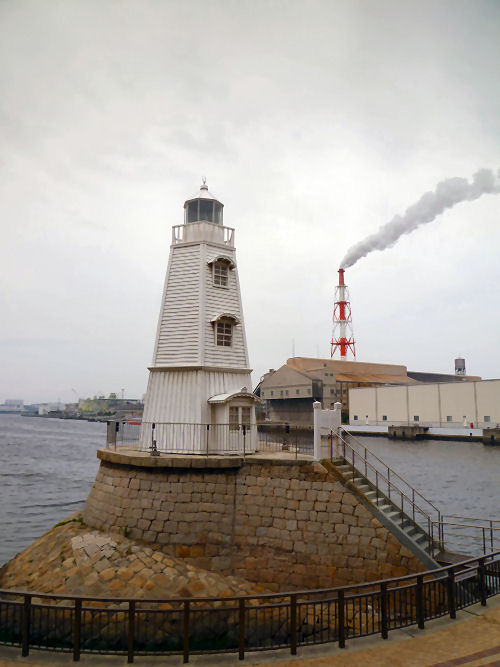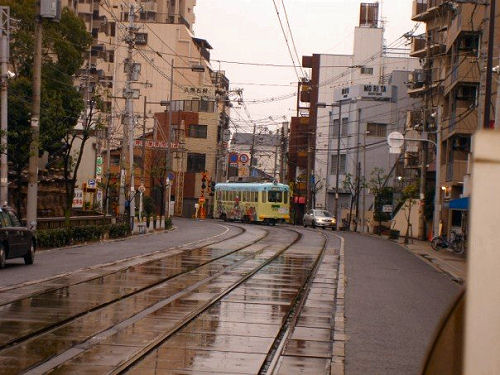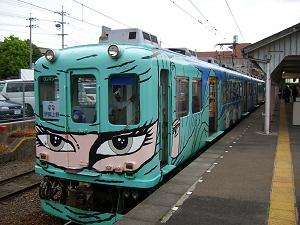Archive
Sakai: Kansai’s Lost City

Historical Old Sakai Lighthouse, with a smokestack in the background
I can’t count the number of times I have heard foreign nationals complaining about the tragic loss of traditional Kyoto. It was one of the few major cities in Japan to be spared bombing of any sort at the end of World War II, and the fact that the old wooden buildings and roadways are mostly gone is due to the demands of modernization.
But I don’t think Kyoto is the great tragedy of Kansai. I don’t even think it has really been lost, as most of its culture and traditions are still intact, its arts are still practiced, and it is respected as the cultural center of Japan by almost all, despite the considerable legacies of places such as Edo and Osaka. And regardless of its considerable size and the laws that make preservation of wooden structures difficult, Kyoto has still managed to maintain a significant amount of its architectural legacy. The real tragedy of Kansai is the city of Sakai, which has become a dreary southern-Osaka suburb and a manufacturing center. Urbanization and modernization have not only created a city that is, for the most part, run-down and depressing, its has chiseled away at the cultural legacy of Sakai to such a degree that most Japanese don’t even know of the city’s importance in Japanese history and culture.
One of the more well-known facts about Sakai is that it has historically produced the best-quality blades in Japan, and most consider it to be one of the great centers of blade production (mostly cutlery in modern times) in the entire world. Sakai swords will set you back nearly a life savings, and genuine swords today are considered national treasures, and thus cannot be legally taken out of the country. Sakai was also a pioneer of early bicycle manufacturing in Japan, and even now produces are large amount of Japan’s bicycles. There are many crafts still done by hand in Sakai, including dying of cloth, painting of koi-nobori (Sakai is one of the rare places where this is still done by hand), and wood carving.
And let’s not forget one of the most influential cultural legacies to come of out Sakai, the tea master Sen no Rikyu, who was history’s most influential figure in developing and solidifying the art of Japanese tea ceremony–he was important enough to be the personal tea master of both Oda Nobunaga and Toyotomi Hideyoshi, two of history’s greatest shoguns and rulers. Sen no Rikyu was held in such high esteem that he helped host a tea ceremony for the emperor, and was bestowed with an honorary title as a result. And if Sen no Rikyu isn’t enough to impress you, try opening Google Maps and taking a look at some of the largest ancient imperial tombs in existence (in carefully executed keyhole shapes, large enough to be seen from space), which are scattered here and there throughout Sakai City. When excavated, these tombs contained some of the most valuable artifacts from ancient Japan that have been found, revealing a massive amount of information about ancient Japanese history, art, culture and lifestyle. And the reason these tombs are in Sakai? Because that region is where the emperors first reigned over Japan, long before Nara and then Kyoto became the capitals in the late 8th century AD.
Sakai started as a fishing village–many of the temples and shrines, including the impressive Sumiyoshi Grand Shrine, are dedicated to deities said to grant safety at sea. It later developed into a merchant town, much like its bigger neighbor Osaka, except that in the case of Sakai it was an autonomous, self-governed body (a “free city,” or 自由都市)–this was also the case with other cities in Japan at the time, including the thriving merchant town of Hakata in Kyushu. It was during this time that all the skilled crafts and arts, which are still around today but greatly under-appreciated, began to develop rapidly. Sakai was also growing into an important trade hub during this time (mostly domestic trade). Around the time of the Meiji Restoration (1868), Japan was following a similar path of “modernization” to that of Europe and the United States, but it had to industrialize more quickly in order to keep up with the world’s other top powers and avoid falling prey to imperialism. This meant that cities like Sakai grew quickly, and factories started sprouting up here and there, polluting the air and making for the start of what would come to be a dreadful cityscape. Like many other cities, Sakai was firebombed by allied forces (mostly American) near the end of World War II–according to Wikipedia statistics, 48.2% of the city was destroyed. The postwar period of high-speed growth in Japan led to further industrial development of Sakai, and today there are many large artificial islands filling the bay. Although it is better than in recent years, Sakai has not seen the shift toward a commercial rather than industrial economy as Osaka has, and smoke and sulfurous smells still fill the air near the bay.

Hankai streetcar rounding a corner near Sumiyoshi Grand Shrine
Today, Sakai aims to become a model environmental city for Japan, and the national and local governments have put money and effort into achieving this end. Promising projects, such as the collaborative solar plant and factory project recently built by Sharp and Kansai Electric Power, do make it seem as if real effort is being made, but a visit to the city makes it painfully clear that Sakai still has decades (at least) before it can revert back to being a cultural icon and highly livable city. Personally, I don’t think building more is the answer; I think reducing polluting industries, expanding transportation infrastructure, enhancing technologies to cut down on pollution, and drawing in non-polluting business will be a start toward the model “green city” goal. The building of a new national (and international) soccer training facility in Sakai is seen by some as a promising new direction, especially considering its convenient location near Osaka City and Kansai International Airport.
Sakai has also made strong efforts to promote tourism in recent years, including producing sightseeing-related materials. If possible, this is something I want to promote as well. Sakai is friendly city with a fascinating and unique history, and many of its older citizens are struggling to keep its fading culture and customs alive despite disinterest among youth. Considering how tough things have been for the tourism industry after the recent earthquakes and tsunamis, and also the fact that Sakai is located right next door to bigger attractions such as Kyoto, Nara, and Osaka, it’s not going to be an easy fight. But for those of you who want to delve deeper see a more unique side of Japant, here are some places I recommend visiting:
- Nanshuji Temple: A Zen temple with a rich history, a 5-7 min. from Goryo-mae Station on the Hankai Streetcar Line
- Mozu Tumulus Cluster: The ancient keyhole-shaped tombs of great emperors, scattered throughout the city (many are concentrated near Mozu Station on the JR Hanwa Line)
- Sakai City Museum: An interesting and to-the-point museum that provides an overview of Sakai’s history, a 5 min. walk from Mozu Station on the JR Hanwa Line (near the imperial tumuli)
- Myokokuji Temple: The site of a famous samurai suicide and a 1,100-year-old cycad tree, a 5 min. walk from Myokokuji-mae Station on the Hankai Streetcar Line or a 10-15 min. walk from Sakaihigashi Station on the Nankai Koya Line
- Old Sakai Lighthouse: A lighthouse on Osaka Bay that was originally built in 1877, a 10-15 min. walk from Sakai Station on the Nankai Main Line
- Hankai Streetcar: Hankai is the only remaining streetcar operator in Osaka, and there are two lines running from Osaka (starting at Tennoji and Ebisucho) down into Sakai
Let’s not let this unique and fascinating gem of Japan slip away through negligence. I truly hope that Sakai, a casualty of development and centralization, will one day return to its former glory. At the very least, I hope it will not be forgotten.
Check out the Sakai Tourism and Convention Bureau’s sightseeing guide and Sakai City’s sightseeing guide, or stop by a tourism information center at one of the major JR or Nankai train stations where information is available in English and other languages.
Exploring Kansai: Day Trips from Osaka

Giant Buddha at Todaiji Temple, Nara
So far I’ve spent a lot of time talking about what there is to do in Osaka, but this time I want to give a quick overview of places that can be visited as day trips from Osaka. It is, in fact, the perfect city for this, because of its central location and its function as a transportation hub for the Kansai area.
The obvious destination is Kyoto, which is by far the most popular tourist destination in Japan among both domestic and international tourists. Then is nearby Nara (the imperial capital from 710-794, before it moved to Kyoto), which like Kyoto is home to a number of famous temples and shrines including Todaiji, Koryuji, and Kasuga Taisha. I prefer Nara over Kyoto because it feels more genuine and is not as crowded. Kobe is known as a pleasant, cosmopolitan city with an international feel–I recommend the waterfront Meriken Park, which is a romantic hot spot at night. Then there’s Himeji, with its soaring castle that is more famous and impressive than any other in the country.

Wakaura Tenmangu Shrine, Wakayama City
If you’re looking for something new, why not try Wakayama City? It has a number of gorgeous old temples, some great food, and lovely beaches and hot spring areas. Iga, one of the two great ninja towns of Japan (the other being Koga in Shiga Prefecture), is located in Nara Prefecture and features a ninja museum that you’re sure to get a kick out of. Kumano Kodo, a pilgrimage route that has been celebrated since ancient times, has recently become popular after being named as Japan’s newest UNESCO World Heritage Site.
Yoshino is famous for its autumn colors and spring cherry blossoms, and also has a number of lovely old ryokan and baths. Further east is Ise Shrine (in eastern Mie Prefecture), the most important Shinto shrine in Japan. It is connected to the imperial family, and it has been rebuilt every 20 years on alternating lots using the same architecture and materials since the beginning of Japan as a unified civilization.

Ninja train, Iga

Yes, there are even ninjas inside the ninja train.
Heading north from Osaka, you will find Uji, which is famous for it matcha powdered green tea, and also for Byodoin, a graceful temple that is meant to be an earthly re-creation of the Buddhist paradise (you can find it pictured on the ten yen coin). Fushimi-Inari Shrine is a complex winding its way up a mountainside, featuring paths lined with thousands of bright-orange torii gates that create an impressive tunnel-like effect. The Lake Biwa area is also a treasure trove of great places to see and delicious foods to eat (read about my journey around the lake here).
There are more options available, but the places listed above are all great destinations for day or weekend trips out of the city. With the autumn leaves reaching their colorful peak, now is the perfect time to experience the many faces of the Kansai region.
Recent Comments